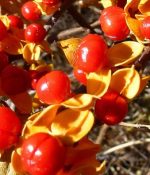
Oriental bittersweet is a deciduous woody, climbing or trailing vine belonging to the bittersweet family, Celastraceae, that also includes crucifixion thorn and euonymus. It is native to northern China, Japan and Korea was introduced to North America in 1879 as an ornamental, is naturalized, and is now considered invasive from New England to Minnesota, south to Georgia and Texas where it is commonly found in old homesites, fields, and roadsides. The vine is adaptable to a variety of habitats, very fast growing, has a high reproductive rate, is spread by birds and mammals that eat the fruit. It hybridizes with American bittersweet, Celastrus scandens. Its ability to form beneficial relationships with mycorrhizal fungi allows it to maximize nutrient uptake and thereby have a significant advantage over native plant species.
Description: The spindly, reddish brown striated stems of oriental bittersweet can grow up to 60′ long and cover nearby shrubs and trees, killing them as they weight them down or deprive them of sun. The light green leaves are two to five inches long and elliptical to circular. The small, inconspicuous greenish-white male and female flowers are axillary and appear on different plants from late spring to early summer. They give way to small round fruits that are green at first but ripen to yellow, and split open to reveal scarlet berries that persist into winter and are valued by flower arrangers. Spreads by seeds and suckers.
Control: Cut the stems to the ground every week or two until they stop sprouting. Alternatively, cut the stems down to the ground and apply a dense mulch like newspaper or cardboard. In severe cases, a systemic herbicide like glyphosate or triclopyr can be applied to cut stems being careful to avoid contact between desirable plants and the herbicide. Foliar application of the herbicide is an option in areas where there are no desirable plants but may not be as effective as application to cut stems. The timing of herbicide application is dependent on the desirable plants that may be nearby to minimize the impact of the herbicide on them i.e. if herbaceous plants are involved spray before they have emerged in spring or after the first killing frost in fall. If desirable grasses are involved use triclopyr as it selective for broad leafed plants and will not hurt the grasses.